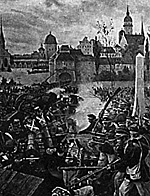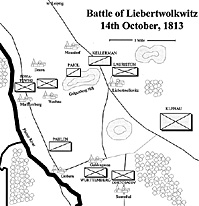Things were beginning to look good after Dresden, until Napoleon was once more let down by incompetent subordinates, primarily Macdonald and Oudinot, although Ney wasn't exactly on sparkling form either, it must be conceded. The three Allied field armies, Bohemia, Silesia and the North, were all still intact, and time was on their side. It was Napoleon who needed an expeditious victory. The major advantage was his central position, dominating Saxony. He determined to strike against Blucher's Army of Silesia, whilst having Murat delay Schwarzenberg. This in itself would not have been a big task for a man with a 'halt' sign, for the Army of Bohemia was largely uninterested in anything approaching a violent confrontation without support. In truth it was not in Austria's interest to see France soundly defeated, leaving Russia and a re-burgeoning Prussia on the immediate political scene.
However at length even Schwarzenberg realised that there was an opportunity to attack Napoleon, particularly following the desertion of the Bavarian contingent, and the obviously aggressive stance posed by Blucher, and he began pushing Murat back towards Leipzig, attacking him with Wittgenstein's cavalry between Liebertwolkwitz and Wachau. Murat was under orders from Napoleon to buy the necessary time for the French forces to form on Leipzig without getting involved in a serious action.
Murat had under his command Kellermann's IV Cavalry Corps of 2000 troopers, all Poles, Pajol's V, numbering the best part of 6000 sabres, Berkheim's Division from I Cavalry Corps with another 1000 men, plus Poniatowski's VIII Corps, with 5,500 bayonets, 600 sabres and 30 guns; Victor's II Corps with 15000 bayonets and 55 guns and Lauriston's V Corps with 12000 bayonets, 700 sabres and 50 guns. This comes to around 10,300 cavalry, 32,500 infantry and 135 guns.
Wittgenstein commanded Pahlen's converged Cavalry Corps of 6000 sabres, 2500 infantry and 44 guns; the Russian I Corps (Gortchakov) with 7000 bayonets, 1000 sabres and 36 guns; the Russian II Corps (Eugene of Wurttemburg) with 5000 men and 24 guns and the Austrian IV Corps (Klenau) with 21000 bayonets, 3000 sabres and 56 guns, totalling 10,000 cavalry, 35,500 infantry and 160 guns.
Wittgenstein was aware from his patrols that Murat had fallen back to occupy the heights between Markkleeburg and Liebertwolkwitz, and believing this force to only be a rearguard, he ordered his cavalry forward, to be followed by the infantry. In fact, Murat's force was much stronger than a rearguard, and the terrain he held was ideal cavalry country, with gentle slopes, although this had been marred by the awful weather, which had left much of the ground boggy and unsound. With the end of the rain had come thick fog, and when it lifted at about noon the battle got underway.
Pahlen vanguarded by his Cossacks, began the advance and it was soon clear that the ground between Markkleeburg and Wachau was held in considerably more strength than had been perceived. He pushed first the Suomi Hussars and then the Grodny Hussars forward to support Illowaiski's Cossacks who were skirmishing heavily with Victor's infantry, backed up by Kellermann's cavalry. Behind Pahlen, the Russian II Corps moved up in support.
Receiving orders from Wittgenstein, Pahlen then proceeded to lunch a full assault against Victor. Seeing this L'Heritier and Subervie advanced their cavalry, and a to-and-fro affair began against the Russian hussars, with neither side getting a distinct advantage. The Prussian Neumark Dragoons were then committed, followed by the rest of Pahlen's Prussian horse, who caught the French reforming and swept them back. The French then countered again with Murat personally involved. Indeed at one point Lieutenant De Lippe of the 1st Neumark Dragoons attempted to take Murat prisoner, repeatedly shouting "Stop, King!" "Stop, King!" (clearly mistaking Murat for Elvis in the confusion), before being killed by Murat's attendant, to whom Napoleon subsequently gave the Legion of Honour.
Following all this backwards and forwards stuff there followed something of a natural break as both sides evaluated what they had lost and gained. On the Allied right Paumgarten's Brigade from the Austrian IV Corps was advancing, with orders to attack Liebertwolkwitz from the north, but he found himself confronted by elements of V Corps who he tentatively engaged with his Advance Guard of Grenz, without much enthusiasm. On the opposite flank Poniatowski's Poles had been skirmishing with more Cossacks, and despite a brief scuffle between the Polish horse and Prussian Cuirassiers little of significance occurred, other than a rare successful charge by Prussian militia cavalry, admittedly taking the Poles by surprise.
Whilst all this as going on Wittgenstein ordered Klenau to take Liebertwolkwitz, and already in position, Klenau moved off just after noon, deploying out of dead ground to storm the town, held by Lauriston. Despite weight of numbers it was two hours before Liebertwolkwitz was in Austrian hands.
Having regrouped his cavalry, Murat now threw forward Milhaud who was in turn countered by Roeder who drove back the French dragoons with a flank attack., but the Prussian Cuirassiers over-pursued and were roughly handled in turn, and the to-and-fro started again, with neither side gaining either ground or advantage. It had now gone 2.30pm and nothing had been resolved.
Murat reformed Milhaud and L'Heritier, spearheaded by the Polish cuirassiers, but despite good initial penetration they were thrown back by the Austrian cavalry, who for the first time during the fighting succeeded in gaining a telling advantage. Had this been followed up then Murat's selection of Leipzig as the focal point for the coming Battle of Nations might have been under threat - for it was indeed he who chose it, subsequently sanctioned by the Emperor. However Wittgenstein dithered badly and Murat found that he had time to launch an infantry assault of his own to retake Liebertwolkwitz. This went in at 4.00pm and by six the Austrians had been ejected, Klenau withdrawing his battered troops under cover of darkness. With this came the end of the fighting.
The most notable detail of the battle is Murat's poor tactics when attacking with his cavalry. Despite an advantage in numbers on two occasions he formed his troopers up in close columns, to use as battering rams, with the result that they were easily outflanked and driven off. Clearly the men that Murat had to hand were not of the same calibre as those lost in Russia, and this may account for his choice of formations.
As for Wittgenstein, he failed to take advantage of a poor opponent by being even worse, and at the end of the day several thousand men had died for absolutely nothing. Fortunately this has never mattered too much to a Russian.
Both sides suffered about 2000 casualties, most of the Allied being Austrians who had done the dirty work at Liebertwolkwitz. The battle turned into a real meeting engagement with very similar forces, and both sides intent on attacking. In fact, if you have enough cavalry, it would make a pretty good wargame.
As a wargamer the most interesting thing is reading the description of the indecisive cavalry battles. It is very reminiscent of fighting using Gilder's Grand Manner. I can just picture Murat and Wittgenstein with huge handfuls of dice!
 Elsewhere in this issue (see The Fighting Marshals) you can read my biased opinions about Murat's career, but here in particular I will take you through the salient points of the grandest cavalry battle of the Napoleonic Wars. The background to the Leipzig Campaign is common knowledge, but suffice to say that following the unsuccessful armistice which itself followed the indecisive victories of Lutzen and Bautzen, Napoleon was looking for the killer blow that would fragment the Allies and allow him to defeat them in detail.
Elsewhere in this issue (see The Fighting Marshals) you can read my biased opinions about Murat's career, but here in particular I will take you through the salient points of the grandest cavalry battle of the Napoleonic Wars. The background to the Leipzig Campaign is common knowledge, but suffice to say that following the unsuccessful armistice which itself followed the indecisive victories of Lutzen and Bautzen, Napoleon was looking for the killer blow that would fragment the Allies and allow him to defeat them in detail.

Back to Table of Contents -- First Empire #34
© Copyright 1997 by First Empire.
This article appears in MagWeb (Magazine Web) on the Internet World Wide Web.
Other military history articles and gaming articles are available at http://www.magweb.com